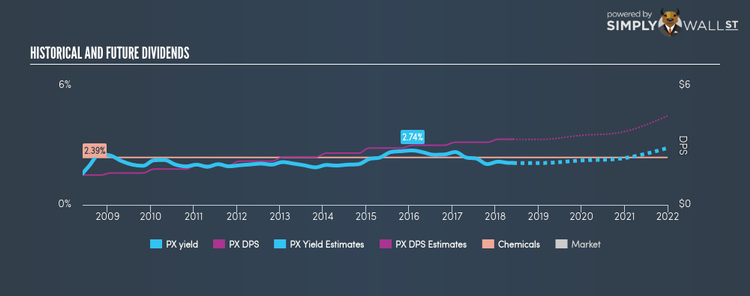Read This Before Buying Praxair Inc (NYSE:PX) For Its Upcoming $0.83 Dividend

Have you been keeping an eye on Praxair Inc’s (NYSE:PX) upcoming dividend of $0.83 per share payable on the 15 June 2018? Then you only have 3 days left before the stock starts trading ex-dividend on the 06 June 2018. Is this future income a persuasive enough catalyst for investors to think about Praxair as an investment today? Below, I’m going to look at the latest data and analyze the stock and its dividend property in further detail. View our latest analysis for Praxair
5 questions to ask before buying a dividend stock
When assessing a stock as a potential addition to my dividend Portfolio, I look at these five areas:
Is its annual yield among the top 25% of dividend payers?
Does it consistently pay out dividends without missing a payment or significantly cutting payout?
Has dividend per share amount increased over the past?
Is its earnings sufficient to payout dividend at the current rate?
Will it have the ability to keep paying its dividends going forward?
Does Praxair pass our checks?
The company currently pays out 69.25% of its earnings as a dividend, according to its trailing twelve-month data, meaning the dividend is sufficiently covered by earnings. However, going forward, analysts expect PX’s payout to fall to 51.60% of its earnings, which leads to a dividend yield of around 2.24%. However, EPS should increase to $6.93, meaning that the lower payout ratio does not necessarily implicate a lower dividend payment. If there’s one type of stock you want to be reliable, it’s dividend stocks and their stable income-generating ability. PX has increased its DPS from $1.5 to $3.3 in the past 10 years. During this period it has not missed a payment, as one would expect for a company increasing its dividend. These are all positive signs of a great, reliable dividend stock. Compared to its peers, Praxair generates a yield of 2.11%, which is on the low-side for Chemicals stocks.
Next Steps:
With this in mind, I definitely rank Praxair as a strong dividend stock, and makes it worth further research for anyone who likes steady income generation from their portfolio. Given that this is purely a dividend analysis, I recommend taking sufficient time to understand its core business and determine whether the company and its investment properties suit your overall goals. There are three fundamental factors you should look at:
Future Outlook: What are well-informed industry analysts predicting for PX’s future growth? Take a look at our free research report of analyst consensus for PX’s outlook.
Historical Performance: What has PX’s returns been like over the past? Go into more detail in the past track record analysis and take a look at the free visual representations of our analysis for more clarity.
Other Dividend Rockstars: Are there better dividend payers with stronger fundamentals out there? Check out our free list of these great stocks here.
To help readers see pass the short term volatility of the financial market, we aim to bring you a long-term focused research analysis purely driven by fundamental data. Note that our analysis does not factor in the latest price sensitive company announcements.
The author is an independent contributor and at the time of publication had no position in the stocks mentioned.

 Yahoo Finance
Yahoo Finance 
